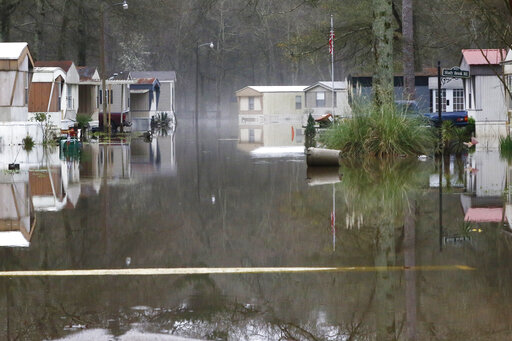Persistent rains have been pounding the Southeast, and a week ago, the Pearl River in Jackson, Mississippi, spilled over its banks, submerging a dozen city blocks in several feet of water.
The river had crested at 36.7 feet—its third-highest level on record. Yet the damage to homes could have been much worse,according to Hinds County Emergency Management Director Ricky Moore. In a survey conducted a few days ago, the county found that hundreds fewer homes had been impacted compared to the last big flood, he said.
The unlikely hero of this story is the Ross R. Barnett Reservoir just north of town. Before the flooding, the waters in the reservoir were far below their peak capacity. That’s because the city had opened up the dam weeks earlier to let water flow out in an effort to clear an invasive plant.
The result was that when storms stalled over the county and dropped unexpectedly large amounts of rain, the engineers had space in the lake basin to “store” tens of thousands of cubic meters of water. Eventually the basin filled and more water had to be released, but the delay was long enough for some residents to evacuate with all their possessions and for others to avoid flood damage altogether.
Due to warming temperatures, communities across the world are increasingly finding that previously unimaginable flooding and fire are the new normal. England and Wales are currently also experiencing record precipitation. In fact, some areas of the U.K. received a month’s worth of rain in just one day.
The result is that in many places infrastructure like the Barnett reservoir, which was built in the 1960s and not intended for flood mitigation, now has a critical role to play in holding back cresting waters. Local authorities are finding themselves playing a more active role in water management.
“We are seeing this across the country,” says Harriet Festing, co-founder and executive director of the Anthropocene Alliance, a nonprofit group that organizes grassroots communities most impacted by flooding. “In cities like Chicago and Detroit, it is people’s basements that are serving this purpose of taking up overflow waters. In other places, it is the local reservoir.”
However, the aging infrastructure is often fragile and imprecise. Moreover, Festing says that unlike in Jackson, many decisions on whether or not to use local infrastructure in flood mitigation comes with winners and losers. Controlling flood waters through local dams and reservoirs has been controversial.
People who live lakeside often don’t like to see the water lowered by their vacation properties. And then there is the risk that if local authorities hold flood water too long, the water will either back up and flood properties upstream or surge forward and overcome the dam—causing a worse flood.
Outside of Houston, there have been big battles around Lake Conroe. Those downstream want seasonal lowering of the lake for flood protection. But people who live on the lakeshore want to keep water levels high to protect their property values. They are not as susceptible to flooding because their homes are on higher ground.
Senator Jim Inhofe, a Republican from Oklahoma, added an amendment to a recently passed law that limits the ability of the Grand River Dam Authority’s ability to consider the impact of raising lake levels on upstream residents. Those residents have argued that high levels in Grand Lake cause water to backup and flood their homes— sometimes catastrophically. However, Inhofe has a summer home on the lake and a yacht that requires deep water.
“We are pitting resident against resident,” Festing says. “Instead of we should be standing back and saying we have much bigger problem and come up with a plan for how to mobilize the infrastructure we have in an organized and fair way.”
About the photo: Standing floodwater from the Pearl River still surrounds a number of mobile homes in the back portion of the Harbor Pines community in Ridgeland, Miss., Tuesday. Some residents are allowed temporary permission to enter their homes in the non-flooded portion of the mobile home community to retrieve clothing and prescriptions. (AP Photo/Rogelio V. Solis)
Was this article valuable?
Here are more articles you may enjoy.


 Toyota Unveils Concept LFA Supercar, and It’s Fully Electric
Toyota Unveils Concept LFA Supercar, and It’s Fully Electric  Verlan Files Subro Suit Against Georgia Chemical Plant After $20M Payout on Fire
Verlan Files Subro Suit Against Georgia Chemical Plant After $20M Payout on Fire  Atmospheric River to Flood Pacific Northwest Through Week
Atmospheric River to Flood Pacific Northwest Through Week  Asahi Sales Drop Worsens as Cyber Hack Disruption Lingers
Asahi Sales Drop Worsens as Cyber Hack Disruption Lingers 